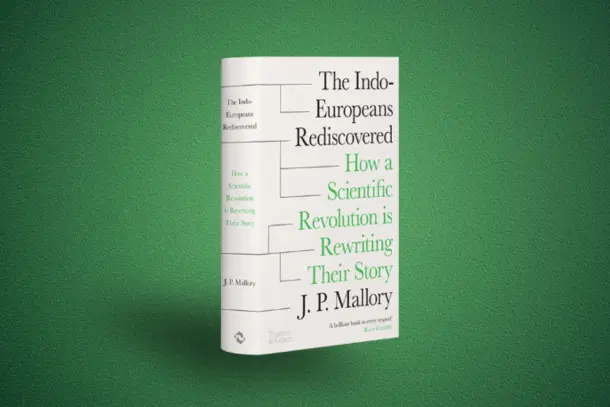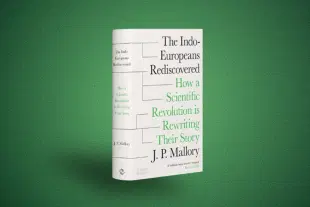Books
Chasing Shadows: The Endless Search For The Indo-European Homeland
Avatans Kumar
Aug 09, 2025, 08:30 AM | Updated 09:20 AM IST
Save & read from anywhere!
Bookmark stories for easy access on any device or the Swarajya app.


The Indo-Europeans Rediscovered: How a Scientific Revolution Is Rewriting Their Story. JP Mallory. Thames & Hudson. Pages: 447. Price: Rs 2923
On 2 February 1786, Sir William Jones delivered a speech to the Royal Asiatic Society of Bengal that would renew and intensify the search for a homeland of the Indo-European languages.
In that Third Anniversary Discourse, he made a groundbreaking observation about the similarities between Sanskrit, Greek, and Latin. Many believed, albeit erroneously as we find out later, that what Sir William Jones had earnestly initiated would be settled with the modern advancements in genomic technology.
The quest for the “original” Indo-European homeland defined the field of (Proto)-Indo-Europeanism in academic and popular discourse. It would later become a cornerstone of linguistic, archaeological, anthropological, and genetic research.
For centuries, the quest to uncover the homeland of the Indo-European languages has been a puzzle that continues to captivate and challenge scholars, maintaining its allure and relevance. The pursuit, however, is far from over, keeping the scholarly community engaged and intrigued.
The Indo-European languages, the most prominent language family in the world, connect over 2.6 billion native speakers globally, underscoring their significant role in our interconnected world. This global significance makes the audience feel connected and part of a larger narrative. Yet, the idea that these languages somehow originated from a single, ancient, prehistoric population remains a complex and contentious issue.
Archaeologist and Indo-Europeanist J. P. Mallory’s book The Indo-Europeans Rediscovered: How a Scientific Revolution is Rewriting Their Story presents an exhaustive account of Indo-European homeland-hunting from over 40 years of research. It offers fresh insights into the controversies surrounding the origin and subsequent dispersal of Indo-European languages and the people who speak them.
In this compelling account, Mallory delves into ancient migrations, linguistics, archaeology, and cutting-edge genetic research to untangle key arguments in the hunt for the homeland. He also sheds light on the contentious concept of a single, shared homeland and its exploitation for political gain, navigating through some of the darker aspects of academic discourse.
Mallory analyses the linguistic trail that links current populations to the Indo-Europeans, examining Sanskrit, Greek, Latin, and other languages as he traces the linguistic origins across multiple peoples and cultures, drawing on the most up-to-date phylogenetic research to inform this narrative.
Ultimately, this book provides the most comprehensive and nuanced understanding of a frequently misinterpreted and misunderstood topic.
The Hunt for a Homeland
The hunt for the Indo-European homeland, the Urheimat, according to Mallory, is a prehistorical quest, not a historical one, as it positions the Indo-European homeland “temporarily before the existence of relevant written records.”
Although the hunt for the Indo-European homeland, spurred by Sir Jones’ speech mentioned earlier, has been a topic of interest, the relationship among languages based on similarity, at least in words and sounds, had been noted and discussed in ancient times. Scholars were aware of the resemblance between Latin and Greek.
The discovery of Sanskrit, the ancient language of the Indian subcontinent, by the West, while on one hand placing a spoke in the Indo-Europeanists’ wheel, also changed the course of politics around the world.
Sir William Jones, with his discovery of the similarities between Sanskrit, Greek, and Latin, played a crucial role in the development of Indo-European studies, sparking a new wave of interest and research in the field. His role in inspiring and shaping the field is something the audience can appreciate and feel inspired by.
More on politics later, but as the West became exposed to “the enormity and complexity” of Indian culture through Sanskrit, with its rich heritage in scientific and philosophical texts, it shook the foundational notion upon which the entire Indo-European homeland-hunting enterprise stood.
The discovery of Sanskrit not only expanded the linguistic knowledge of the West but also challenged the existing theories about the Indo-European homeland. The similarities between Sanskrit and other Indo-European languages forced homeland hunters to reconsider their theories, leading to a significant shift in the field of Indo-European studies.
It is important to understand the centrality of the Bible in the epistemological and ontological landscape of the West. History, in this context, began with the Bible, tracing back to creation. The Biblical notion of an original language of the Garden of Eden inspired linguists to reconstruct the vocabulary and the grammar of a Proto-Indo-European (PIE) language.
The exploration of the new world in the East was not intended to challenge the chronology of the Bible, but rather as an opportunity to support its central theses. Sir William Jones remained a defender of the Biblical chronology, “who could find no evidence that could be seen to oppose [the Biblical chronology].”
When we think of Indo-European speakers, a picture of a tall, horse-riding, blonde, blue-eyed pastoralist pillaging through the Pontic-Caspian Steppe comes to mind. These men supposedly migrated in waves, the Indo-European hypothesis tells us, and spread their language and genes throughout Europe and Asia. To give it context, these men, we were told, brought with them the Vedic/Sanskrit culture to the Indian subcontinent. In the process, they also supposedly destroyed the native Indus Valley civilisation.
The hunt for Urheimat, the imaginary homeland, involves a fictional Proto-Indo-European postulate based on the notion of a single ancestor language spoken about 6,000 years ago. Urheimat is a German term that translates to “original homeland,” and it plays a crucial role in Indo-European studies, serving as a theoretical starting point for the study of language evolution and migration.
Linnaean taxonomy provided the initial theoretical framework for language classification. Indo-European, Indo-Iranian, Indo-Aryan, and so on are considered descendants of the Proto-Indo-European school of thought.
Eighteenth-century linguistics, as it strove for scientific legitimacy, adopted models from botany, biology, and comparative anatomy. Linguists like Bopp, Rask, and Grimm treated languages as “organisms” with “structures” governed by physical laws, using terms like “stem,” “root,” “growth,” and “decay.” Franz Bopp described languages as “organic natural bodies” and grammar as their “natural description.”
The Proto-Indo-European is supposed to have originated somewhere north of the Caucasus, in Europe. Other alternatives, including the Indian homeland of PIE, have also been suggested. Needless to say, no one today speaks PIE, and there are no records of it ever being spoken anywhere. The search for the Proto-Indo-European homeland relied on a selective analysis of shared vocabulary across IE languages.
It was argued that the presence of standard terms for blood relatives, for example, but fewer for in-laws, implied distant relationships with in-laws in the original society. Using this approach, it was inferred that PIE speakers knew butter but not milk, and snow and feet but not rain or hands.
A plausible explanation for the spread of Indo-European (IE) languages involves diffusion combined with limited population movements, similar to the spread of Indian culture in Southeast Asia.
Furthermore, a timeline was assigned to oral texts, and specific linguistic changes were proposed to fit the assumed model. In a circular reasoning process, these changes were then used to validate the model. This logic resembles a fisherman using a net with a specific mesh size and concluding the lake contains no smaller fish.
Marija Gimbutas attempted to link archaeology to PIE through her Kurgan hypothesis, tracing the language to the Yamnaya people, horse-domesticating herders from the southern grasslands of present-day Ukraine.
Politicisation and Racialisation
Now, coming to the politics of Indo-European, as I mentioned earlier. Nineteenth-century philologists claimed European languages were closest to Proto-Indo-European (PIE), asserting their superiority in character and scientific knowledge. This belief fuelled European colonialism across Asia, Africa, and the Americas and later underpinned Nazi claims of racial superiority.
Before the 1870s, many Proto-Indo-Europeanists focused on anthropological questions, such as the development of the human mind, language relationships, and their speakers’ connections.
But French Holocaust historian Léon Poliakov (1910-1977) noted a persistent German confusion between language and race, evident in the division of Europeans into “Aryans” and “Semites” based on linguistic-cultural conflations.
Poliakov argued that comparative philology and Indology, the academic study of India, intertwined with German nationalism and Enlightenment anthropology, contributed to the Holocaust.
Friedrich Schlegel, a key figure in modern philology, “biologised” linguistics by linking language history to genealogical descent. He prioritised racial questions, dividing people into those with “divine” languages and those with “savage” ones rooted in “animal cries.” Ruth Römer notes his influence on nineteenth-century ethnography’s colonial and racist tendencies.
The discovery of Sanskrit’s rich scientific and philosophical texts led German Indologists to link it to PIE. A. W. Schlegel praised Hindus as “most noble” for their social order and intellectual achievements, but relegated them to an inferior position. This thinking spawned fictional Aryan migration theories, destabilising Indian history, society, and politics.
Advent of Genetics
Some of the most significant changes that came about in the world of PIE homeland-hunting, Mallory writes, came from two genetics papers: the Harvard-Jena (January 2015) paper and the Copenhagen (February 2015) paper.
The two papers, Mallory writes, “put migration back on the archaeologists’ agenda.” Mallory calls these papers “game-changers,” but as he mentions, “the game [was] far from over.”
As we have seen already, the hunt for the IE homeland became racialised over time. German anthropologist Otto Reche (1879-1966) argued, according to Mallory, that “[r]ace and language have been associated with one another from the very beginning.” Reche also argued that it was inconceivable for two entirely distinct races to develop the same language or for a single race to create two completely different languages. However, we know, and Mallory reminds us, that there is no direct causal link between a person’s genome and the language they speak. Any human can learn any language, and any connection between language and genetics is historical, not inherently biological.
What brought linguistics and anthropology together was their understanding of “history” and “race.” The anthropological approach was “a blatant product of a racist or nationalistic agenda.” Many would argue that anthropology and linguistics were not separate fields of inquiry, at least initially. What brought linguistics and anthropology together was the complex of methods, ideologies, and inquiries that gave rise to nineteenth-century racial anthropology.
One of the questions genetics faces is whether a genetic trail exists that can conclusively demonstrate the spread of a language through either migration or invasion/intrusion. To that, Mallory suggests that genetically evidenced migrations and interactions are not the sole mechanisms for language expansion. Other models of language dispersal leave minimal or no genetic evidence.
Language shift typically follows societal bilingualism across various sociolinguistic contexts, where proficiency in the new language offers social benefits. The genetic admixture percentage fails to translate the probabilities of language shift.
In his candid conclusion, Mallory posits that his quest for the Indo-European homeland leaves him where he started. “[After] a half-century of study, I am pretty much where I started: I believe the Indo-European homeland lies in the Pontic-Caspian steppe because it is the one that satisfies the greatest number of constituencies and provides the strongest case for explaining the dispersal of the Indo-Europeans.”
Final Take
The Indo-Europeans Rediscovered is a significant contribution to Indo-European studies. Though some may find the book dull and at times too technical, it delivers a sophisticated and current examination of a multifaceted subject.
J. P. Mallory masterfully integrates diverse disciplines into an engaging narrative, making this book essential for scholars, students, and enthusiasts with some prior knowledge. Though not ideal for absolute beginners, its depth, clarity, and inclusion of recent genetic evidence render it a significant contribution to the field. It offers a definitive yet approachable account of the Indo-European narrative.
As a person of Indian heritage, I would have appreciated a more in-depth discussion of the “Out of India” (OIT) model of Indo-European dispersal, rather than just a few passing references. I was deeply disappointed that works of such Indian scholars as Srikant Talagery find no mention in Mallory’s work. Though dispersal and societal bilingualism have been discussed at some length, the linguistic area (sprachbund) phenomenon — contact, convergence, and assimilation — across genetically distinct language families and its role in Indo-European dissemination has been completely overlooked. Linguistic area is a perfect antidote to some of the conflict narrative that comes with Indo-Europeanism.
The reference to Sir William Jones’ claim (p. 31) that “Indian law [reference to Dharmashastras?] forbade Hindu priests (brahmins) from leaving their country” also caught my eye for its audacious nature. It would have been prudent to verify such claims with native insider scholars, as opposed to depending on etic accounts.
That aside, Mallory’s book is highly recommended for those curious about how modern science is transforming our understanding of ancient migrations and cultural evolution.
Avatans Kumar is a recipient of the California Newspaper Publishers Association and the San Francisco Press Club journalism awards. He is an alumnus of JNU and the University of Illinois at Urbana-Champaign.





